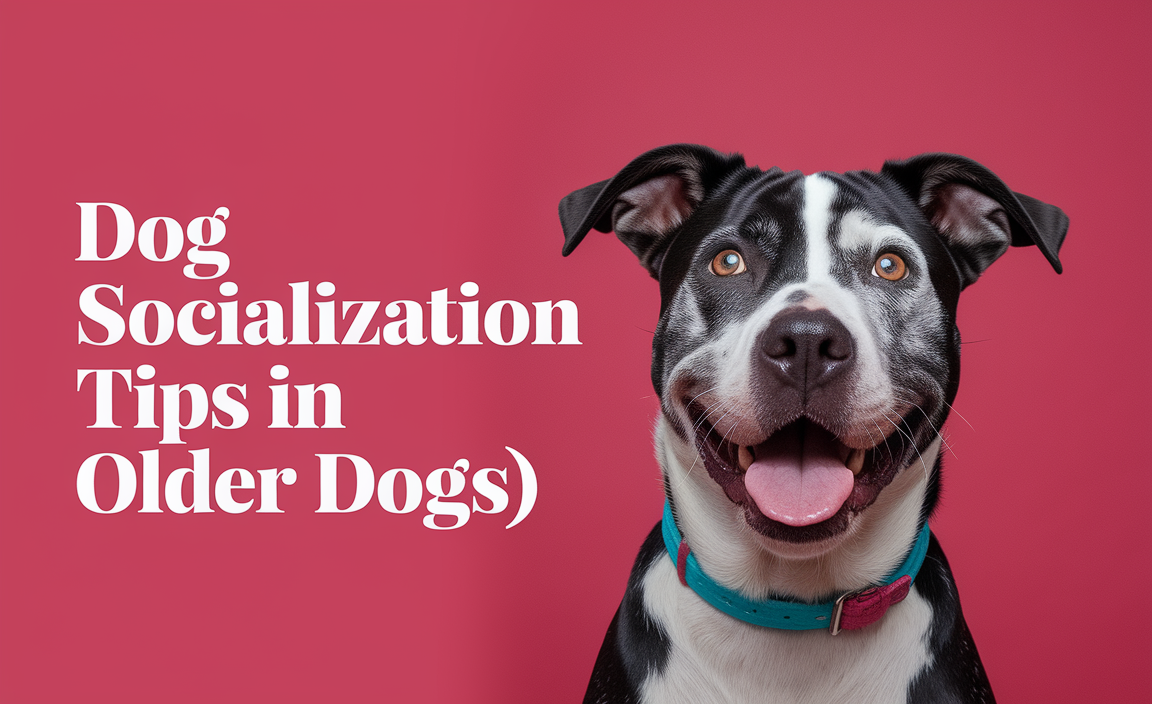Quick Summary: Discover proven dog calming techniques to ease your furry friend’s anxiety. This essential advice provides practical, easy-to-implement strategies for a happier, more relaxed dog, covering everything from environmental changes to expert-approved methods.
Is your dog’s tail tucked, ears flat, or is their whole body trembling when a storm rolls in, the doorbell rings, or you get ready to leave? It’s heartbreaking to see our beloved companions stressed. Many dog owners face this challenge, feeling helpless as their dog experiences fear or overexcitement. But you’re not alone, and there are effective ways to help. We’ll walk through simple, proven methods to bring a sense of calm to your dog’s world, making life better for both of you.
Dog Calming Techniques Advice: Proven, Essential Help for a Happier Pup
As dog lovers, we want our pups to feel safe and content. Sometimes, though, life throws things at them – or us – that cause anxiety, fear, or overstimulation. Whether it’s loud noises, separation from their favorite human, or a visit to the vet, these moments can be tough. The good news is that understanding how to calm a dog is a skill you can develop. This guide is packed with practical, easy-to-follow dog calming techniques that have been shown to work. We’ll cover everything from creating a serene environment to engaging your dog in calming activities. Let’s dive in and discover how to help your furry friend find their inner peace!
Understanding Why Dogs Get Anxious
Before we get to the solutions, it helps to understand what might be causing your dog’s distress. Dogs experience a range of emotions just like we do, and anxiety is a common one. It’s their natural response to perceived threats, changes in their environment, or uncomfortable situations. Recognizing the signs is the first step to helping them feel better.
Common Triggers for Dog Anxiety
- Loud Noises: Thunderstorms, fireworks, construction, or even vacuum cleaners can be terrifying for some dogs.
- Separation Anxiety: This happens when a dog becomes distressed by being left alone.
- Changes in Routine or Environment: Moving to a new home, a new pet, a new baby, or even a change in your work schedule can disrupt a dog’s sense of security.
- Car Rides: For some dogs, the motion or negative past experiences can cause anxiety.
- Vet Visits or Grooming: Unfamiliar places or handling can be unsettling.
- Past Trauma: Rescue dogs especially might have experienced neglect or abuse that leads to lasting fear.
- Social Anxiety: Some dogs get overwhelmed in busy environments or around unfamiliar people or dogs.
Recognizing the Signs of Stress
Your dog speaks to you through their body language. Learning to read these signals is crucial. When a dog is stressed, they might exhibit:
- Panting when not hot or exercised.
- Excessive yawning or lip licking.
- Whining or barking more than usual.
- Pacing or restlessness.
- Hiding or trying to escape.
- Destructive chewing or digging.
- House soiling when previously trained.
- Loss of appetite.
- Trembling or shaking.
- Low body posture with a tucked tail and flattened ears.
- Shedding more than usual.
If you notice these signs, it’s time to employ some calming strategies. Remember, your calm demeanor will also help your dog relax.
Essential Dog Calming Techniques: A Practical Guide
Helping your dog feel calm involves a multi-faceted approach, combining environmental adjustments, behavioral strategies, and sometimes, helpful tools. Here are some of the most effective and easy-to-implement dog calming techniques.
1. Create a Safe and Secure Environment
Your dog needs a place where they feel completely safe. This is their den, their sanctuary. When they’re feeling anxious, they should have access to this space.
- Designate a “Safe Zone”: This could be a crate, a corner with their bed, or a specific room. Make sure it’s associated with positive experiences, not punishment. Equip it with comfortable bedding, their favorite toys, and maybe a piece of your clothing that smells like you.
- Minimize Triggers: If loud noises are an issue, try to block them out. Close windows and doors, draw curtains, and use white noise machines or calming music to mask external sounds. For fireworks or thunderstorms, keeping them inside and in their safe zone is key.
- Consistent Routine: Dogs thrive on predictability. Maintaining a regular schedule for feeding, walks, and playtime can reduce general anxiety related to uncertainty.
2. Calming Body Language and Interaction
How you interact with your dog during stressful times matters. Your own anxiety can easily transfer to your pet.
- Stay Calm Yourself: Speak in a soft, soothing voice. Avoid overly enthusiastic greetings or petting if your dog is actively anxious, as this can sometimes reinforce the anxious behavior.
- Offer Gentle Comfort: Sometimes, a calm presence is all they need. Sit near them, talk quietly, or offer a gentle, slow stroke. Don’t force interaction if they are trying to retreat to their safe space.
- Avoid Punishment: Never punish a dog for showing signs of anxiety or fear. This will only exacerbate the problem and damage your trust.
- “Yawn” or Blink Slowly: These are canine appeasement signals. Mimicking a slow blink or a gentle yawn can communicate to your dog that you are not a threat and help them relax.
3. Physical and Mental Enrichment for a Calmer Dog
A tired dog is a happy, less anxious dog. Proper enrichment keeps their minds and bodies engaged, reducing pent-up energy that can fuel anxiety.
- Regular Exercise: Tailor exercise to your dog’s breed, age, and health. A good brisk walk, a game of fetch, or a romp in a secure area can significantly reduce stress. For anxious dogs, short, frequent sessions might be better than one long, exhausting one.
- Puzzle Toys and Food-Dispensing Toys: These toys require your dog to problem-solve to get treats or kibble. This mental stimulation is a fantastic way to redirect anxious energy.
- Chew Toys: Chewing is a natural stress reliever for dogs. Provide safe, durable chew toys.
- Training Sessions: Short, positive reinforcement-based training sessions can build your dog’s confidence and strengthen your bond. Focus on positive commands and reward-based learning.
4. Calming Aids and Tools
There are several products and tools designed to help dogs feel more secure and relaxed. While these are not a substitute for behavioral modification, they can be very effective complements.
- Thundershirts or Anxiety Wraps: These garments apply gentle, constant pressure, similar to swaddling an infant. This pressure can have a calming effect on the nervous system for many dogs.
- Calming Music and White Noise: Specific playlists designed for dogs, or even just classical music and ambient sounds, can help mask overwhelming external noises and promote relaxation.
- Pheromone Diffusers and Sprays: Products like Adaptil releases synthetic pheromones that mimic those naturally produced by a mother dog to calm her puppies. These can be plugged into outlets in areas where your dog spends time.
- Calming Supplements: Many over-the-counter supplements contain ingredients like L-theanine, tryptophan, or specific herbal blends that can help reduce anxiety. Always consult with your veterinarian before giving your dog any new supplements.
- Massage and Acupuncture: For some dogs, professional techniques like canine massage or acupuncture can help alleviate physical tension and promote relaxation.
For more information on anxiety management in dogs, the American Veterinary Medical Association (AVMA) offers valuable resources.
5. Desensitization and Counter-conditioning
For specific fears, like thunderstorms or doorbells, these are advanced but highly effective techniques. They require patience and consistency.
- Desensitization: Gradually exposing your dog to the trigger at a very low intensity, so low that it doesn’t cause a fearful reaction.
- Counter-conditioning: Pairing the low-intensity trigger with something your dog loves, like high-value treats or playtime.
Example for Doorbell Fear:
- Start by playing a recording of a doorbell at a very low volume while your dog is relaxed and give them a treat.
- Repeat daily, subtly increasing the volume if your dog remains calm.
- If your dog shows any signs of stress, you’ve gone too fast. Go back to an even lower volume where they are comfortable.
- Once they are comfortable with the sound at a normal volume, have someone ring the doorbell briefly, immediately followed by a treat or praise.
- Gradually increase the duration and frequency of the doorbell rings.
This process takes time and should be done carefully. If you are unsure, working with a certified professional dog trainer or veterinary behaviorist is highly recommended.
When to Seek Professional Help
While these home-based dog calming techniques are excellent starting points, some anxiety issues are too severe to manage alone. If your dog’s anxiety is:
- Severe or debilitating (e.g., they are harming themselves, destroying your home, or cannot be soothed).
- Sudden and without apparent cause.
- Leading to aggression.
- Not improving with consistent at-home efforts.
It’s time to consult with a professional. This could be:
- Your Veterinarian: They can rule out any underlying medical conditions contributing to anxiety and discuss potential prescription medications if necessary.
- A Certified Professional Dog Trainer (CPDT-KA or equivalent): They can help with behavioral modification techniques and guide you through desensitization and counter-conditioning.
- A Veterinary Behaviorist (DACVB): These are veterinarians with specialized training in animal behavior, offering expert diagnosis and treatment plans for complex behavioral issues.
The American College of Veterinary Behaviorists (ACVB) website can help you find a specialist in your area.
A Table of Dog Calming Techniques: Pros and Cons
To help you choose the best approach for your dog, here’s a quick overview of some popular calming techniques.
| Technique | Pros | Cons |
|---|---|---|
| Safe Zone Creation | Provides a secure retreat, reduces overall stress. Easy to implement. | May not be enough for severe anxiety. Requires consistent positive association. |
| Calming Music/White Noise | Masks disruptive sounds, creates ambient calm. Non-invasive. | Effectiveness varies by dog. Requires consistent use during trigger events. |
| Exercise & Enrichment | Reduces pent-up energy, improves mood and confidence. Great for overall well-being. | Requires owner commitment and time. Needs adaptation to individual dog needs. |
| Thundershirts/Anxiety Wraps | Provides constant pressure, which is calming for many dogs. Easy to use. | Not effective for all dogs. Can be cumbersome if not fitted properly. |
| Pheromone Diffusers | Subtle, continuous calming effect. Easy to use passively. | May take time to see results. Effectiveness can vary. Doesn’t address root cause. |
| Desensitization & Counter-conditioning | Highly effective for specific phobias. Addresses root cause. | Requires significant time, patience, and consistency. Can be challenging to implement correctly without professional guidance. |
| Calming Supplements | Can help reduce general anxiety. Accessible over-the-counter. | Must consult vet first. Effects can vary greatly. Not for severe anxiety. |
Frequently Asked Questions About Calming Dogs
Q1: How quickly can I expect to see results from these calming techniques?
The speed of results varies greatly depending on the dog, the cause of anxiety, and the technique used. Simple techniques like creating a safe zone or using calming music might offer immediate comfort. More complex strategies like desensitization can take weeks or months of consistent practice. Patience and consistency are key!
Q2: My dog panics during thunderstorms. What’s the best immediate action?
For immediate relief during a storm, your best bet is to keep your dog inside, in their designated safe zone, with comforting items like their bed or a favorite toy. Use white noise or calming music to mask the thunder. Speak in a calm, soothing voice and offer gentle petting if they seek it, but don’t force interaction. A Thundershirt might also provide quick comfort.
Q3: Can I use calming treats for my dog?
Calming treats can be helpful for mild to moderate anxiety, especially those containing ingredients like L-theanine, tryptophan, or chamomile. However, it’s always best to discuss them with your veterinarian first. They can advise on appropriate dosages and ensure the ingredients are safe for your dog. They are generally best used as a supplement to other behavioral strategies, not as a sole solution.
Q4: My dog is anxious when I leave for work. What can I do?
This is often separation anxiety. Before you leave, ensure your dog has had adequate exercise and mental stimulation. Leave them with a puzzle toy filled with treats. Make departures and arrivals low-key; avoid drawn-out goodbyes or overly excited greetings upon return. Leaving a calming pheromone diffuser on or playing dog-specific calming music can also help. If it’s severe, professional help is recommended.
Q5: Are there natural remedies for dog anxiety?
Yes, many natural approaches can help. These include consistent exercise and mental enrichment, creating a safe and predictable environment, using calming music, practicing calming massage techniques, and considering natural supplements often containing herbs like chamomile, valerian, or passionflower (always consult your vet). Pheromone diffusers are also a natural-smelling approach.
Q6: How often should I practice calming techniques with my dog?
For general well-being, incorporating enrichment, exercise, and positive training should be a daily part of your routine. For specific anxiety triggers, practice is often needed when the trigger is anticipated or occurs, and especially during desensitization/counter-conditioning exercises, which require regular, consistent sessions (often daily or several times a week).
Conclusion: Building a More Peaceful Life for Your Dog
Watching your dog struggle with anxiety is tough, but remember that you have the power to make a significant difference. By understanding the triggers and signs of stress, and by consistently applying these proven dog calming techniques, you can help your furry friend navigate their world with more confidence and less fear. Whether it’s creating a secure haven, engaging them in playful enrichment, utilizing calming aids, or working through desensitization, each step you take builds resilience and strengthens your bond. Be patient, be consistent, and celebrate the small victories. Your commitment to your dog’s emotional well-being will lead to a happier, more harmonious life for both of you. If you ever feel overwhelmed or believe your dog’s anxiety is severe, don’t hesitate to reach out to your veterinarian or a qualified animal behaviorist for expert guidance. Together, you can help your dog find their calm.
Meet Elyse Colburn, the devoted canine companion and storyteller behind the enchanting world of “Tales, Tails, and Adventures Unleashed.” A passionate dog enthusiast with a heart full of paw prints, Elyse Colburn shares heartwarming tales and insightful adventures, celebrating the joy, loyalty, and endless antics that make every dog a true hero. Join Elyse Colburn on this tail-wagging journey, where every post is a love letter to our four-legged friends.






